 |
|
|
| (Information by Peter Kessler, with additional information by Edward Dawson and Trish Wilson, from The Cambridge Historical Encyclopaedia of Great Britain and Ireland, Christopher Haigh (Ed), from The Oxford History of England: Roman Britain, Peter Salway, from Glevum - The Roman Origins of Gloucester, Nigel Spry (Gloucester Civic Trust, 2003), from History of the Kings of Britain, Geoffrey of Monmouth, from the Historia Brittonum (The History of the Britons), Nennius, and De Excidio Brittaniae et Conquestu (On the Ruin of Britain), Gildas (both J A Giles, Ed & Trans, 1841, published as part of Six Old English Chronicles (Henry G Bohn, London, 1848)), from A History of the English Church and People, The Venerable Bede (Leo Sherley-Price translation - revised by R E Latham), from The Anglo-Saxon Chronicles, Anne Savage (translator and collator, Guild Publishing, 1983), and from External Link: A Brief Historical Background (Amesbury Parish Church).) |
|
|
| c.410 - c.446 |
Aurelius Ambrosius (the Elder) |
Roman senator and pro-Roman. Killed by plague. |
| c.410 - 418 |
 Aurelius Ambrosius is the official representative of Roman Emperor Honorius to the British provincial council and is claimed as a prince, marking him out as a member of the Romano-British nobility. The country is reorganising at this time, following the expulsion of Roman administration (see feature link), but links with Rome are clearly being maintained. Aurelius Ambrosius is the official representative of Roman Emperor Honorius to the British provincial council and is claimed as a prince, marking him out as a member of the Romano-British nobility. The country is reorganising at this time, following the expulsion of Roman administration (see feature link), but links with Rome are clearly being maintained. 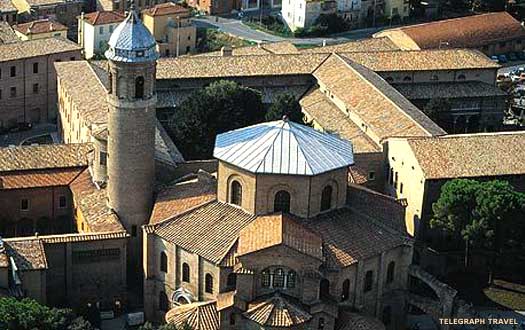 Ravenna became an imperial city in 402, and remained Italy's capital under succeeding Gothic, Ostrogothic, and Eastern Roman administrations, but without Britain or even much of Gaul Ravenna became an imperial city in 402, and remained Italy's capital under succeeding Gothic, Ostrogothic, and Eastern Roman administrations, but without Britain or even much of Gaul |
|
| c.418 - 425 |
This period is said to witness the increasing influence and power of Vortigern of the Paganes, culminating in his securing control of the post-Roman administration of the whole of Britain. Available evidence seems to show that the provincial council decides, and external factors dictate, the need for strong, central, leadership in the country, and the impression is that Aurelius Ambrosius is not strong enough to offer a viable alternative. It seems that he and Vortigern form the figureheads for opposing parties, but for the moment it is the latter who has dominance. |
|
| c.432 - 436 |
Aurelius Ambrosius is apparently a leader of a British council, which presumably answers to Vortigern. It is his decision to confirm the Irish Déisi as commanders of the Demetia area of the west coast to counter the threat posed by Irish raiders. Vortigern acquiesces and assigns Ambrosius 'Dinas Emrys [the fort of Ambrosius] and all the western lands', suggesting that Ambrosius becomes the architect for the defence of these western areas. This is motivated by the council's reluctance to depend entirely upon Saxon mercenaries, with their constant demands for increased provisions, especially in an area in which they would be lightly supervised. The Déisi have already been settled for some time and would be self-supporting. 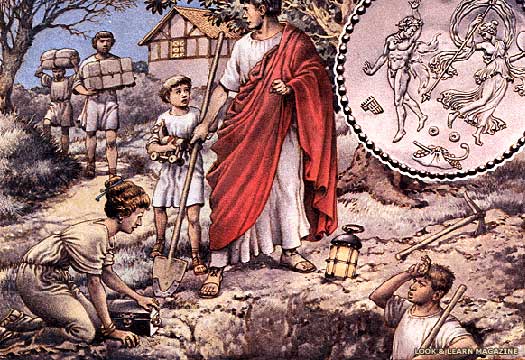 With discord building in the country between about 420-450, many Romano-Britons left in a hurry, burying their wealth in the hope that they could return in better times to collect it With discord building in the country between about 420-450, many Romano-Britons left in a hurry, burying their wealth in the hope that they could return in better times to collect it |
|
| c.437/438 |
According to Gildas and Nennius when referring either to Aurelius Ambrosius or his son, this family represents the Romanised nobility in Britain. It is possible that by this time, as elsewhere, a magistrate is in charge of the governance of Caer Gloui (and seemingly Caer Baddan and Caer Ceri too, given that the three cities are closely linked). Given the later role of Ambrosius Aurelianus in this region, it seems entirely possible (although hypothetical), that his father now fills this position.  Ambrosius (the Elder) has long been Vortigern's main rival (see feature link), with it seeming likely that they not only head two opposing factions in the country, but also opposing ideologies, with Ambrosius retaining his Romanised, Roman Church background while Vortigern is leader of the Pelasgian pro-Celtic party which seems to proliferate within the British Church. Around this year, 437 or 438, internecine warfare breaks out between the two rival factions, resulting in the Battle of Guolloppum (Cat Guolph, today's Wallop in Hampshire - the name is the same, but has been filtered through fifteen hundred years of language evolution). The result is uncertain, but it is probably followed by a period of civil strife in eastern and southern Britain. Ambrosius (the Elder) has long been Vortigern's main rival (see feature link), with it seeming likely that they not only head two opposing factions in the country, but also opposing ideologies, with Ambrosius retaining his Romanised, Roman Church background while Vortigern is leader of the Pelasgian pro-Celtic party which seems to proliferate within the British Church. Around this year, 437 or 438, internecine warfare breaks out between the two rival factions, resulting in the Battle of Guolloppum (Cat Guolph, today's Wallop in Hampshire - the name is the same, but has been filtered through fifteen hundred years of language evolution). The result is uncertain, but it is probably followed by a period of civil strife in eastern and southern Britain. 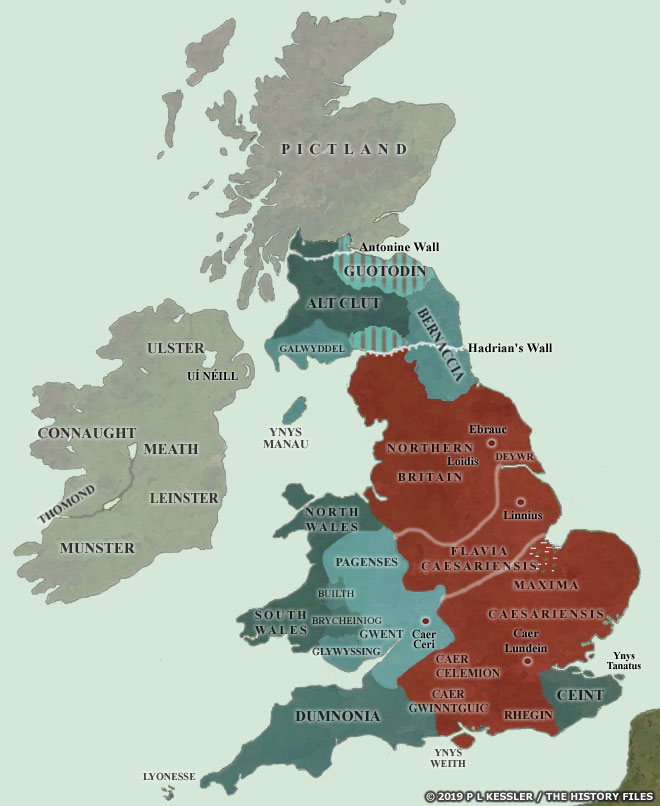 Following the break with Rome in AD 409 there came a period in which central administration apparently began to break down, with no single individual with enough power to hold the Romanised administrative structure together (click or tap on map to view full sized) Following the break with Rome in AD 409 there came a period in which central administration apparently began to break down, with no single individual with enough power to hold the Romanised administrative structure together (click or tap on map to view full sized) |
|
| c.440 - 443 |
In the early 440s the Saxon foederati and laeti revolt, causing widespread chaos and temporarily controlling swathes of the country. Soon after this, the defences of both Caer Baddan and Caer Ceri are repaired. In the latter, flood prevention work is carried out on the Verulamium gate. |
|
| 446 |
Serious plague hits southern Britain and unburied bodies are to be found in the streets of Caer Ceri. The town contracts to some wooden huts inside the amphitheatre. It is this point at which Ambrosius the Elder, who must be an old man in his sixties, also dies, 'in these same broils', ie. the Saxon revolt, although according to tradition it is the plague which actually claims him. Ambrosius' surviving family is in hiding by now (traditionally in Armorica), avoiding the vengeful clutches of Vortigern. An archaeological excavation at a site in modern Gloucester produced an early fifth-century secondary burial in a Roman funerary building, with indications that the male inside had been of high rank - perhaps Ambrosius the Elder himself? |
|
| 446 - 455 |
At the same time as the Anglo-Saxon mercenaries in the east revolt against British controls (in 455), the entrance to Caer Gloui's amphitheatre is reduced in size to make it easier to defend. Life continues, as evidenced by fifth and sixth century pottery. 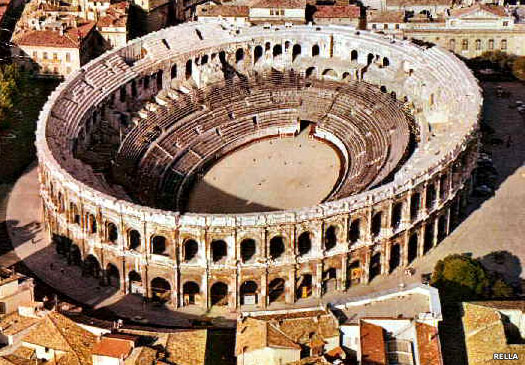 Times were tough in the mid-fifth century, and Britain's resources were not what they had once been, what with barbarians at the door and withdrawal from the fading Roman empire, so Caer Gloui's amphitheatre had to be made defendable (Nemausus (Nimes) amphitheatre is shown here as an example) Times were tough in the mid-fifth century, and Britain's resources were not what they had once been, what with barbarians at the door and withdrawal from the fading Roman empire, so Caer Gloui's amphitheatre had to be made defendable (Nemausus (Nimes) amphitheatre is shown here as an example) |
|
| There is a gap in what can be pieced together of the story at this point, with Ambrosius Aurelianus, the son of Ambrosius the Elder, not emerging into British affairs until perhaps 455 or 460. Given the period at which he appears to be at his most influential, his date of birth is probably around 430, making him too young to succeed his father immediately as a possible magistrate of Caer Gloui, so it seems likely that someone else, a possible deputy or one of Vortigern's supporters, assumes command. |
|
|
| c.446 - c.455? |
? |
Name unknown, possibly a deputy of Aurelius Ambrosius. |
| c.455 - c.480? |
Ambrosius Aurelianus |
Son of Aurelius Ambrosius. Magistrate? High King? |
| c.455 - c.496 |
Ambrosius (and perhaps the elusive Arthur after him) seems to base himself in the territory of Caer Gloui. Amesbury (which in a Saxon charter of about 880 is spelled Ambresbyrig, 'the stronghold of Ambrosius'), which is located on the territory's eastern borders, is perfectly suited to be the focus of Ambrosius' military operations.  He probably governs the territory as a Roman magistrate rather than as a princeps or king (although he is claimed as the first king by later chroniclers, and see feature link). It seems likely that the Wansdyke is constructed around this time, possibly in response to further Saxon incursions to the east. He probably governs the territory as a Roman magistrate rather than as a princeps or king (although he is claimed as the first king by later chroniclers, and see feature link). It seems likely that the Wansdyke is constructed around this time, possibly in response to further Saxon incursions to the east. 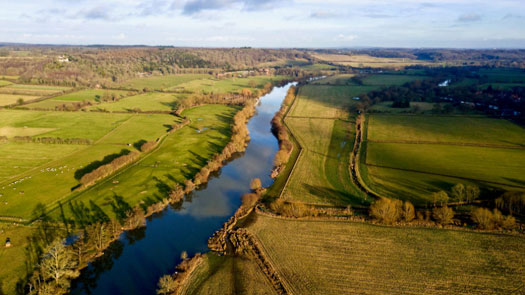 The Thames Valley forms an east-west passage through the hills between London and Surrey and also through the hills of Wiltshire, providing easy access for river users to the River Avon around Bath The Thames Valley forms an east-west passage through the hills between London and Surrey and also through the hills of Wiltshire, providing easy access for river users to the River Avon around Bath |
|
Groups from the Thames Valley appear to force their way into the western end of neighbouring Cynwidion while further groups from the Middil Engle push through the Vale of Aylesbury to complete the encirclement of that kingdom, exposing Caer Ceri's eastern border in the process. There is the possibility that during this period Glevum's residents leave in some numbers to head to Cernyw, on the other side of the Severn, although the connection is tenuous apart from the change in that kingdom's name to Glywyssiog around 470-480.  All building and repair work on major new defensive works probably comes to an end with the British victory of Mons Badonicus around 496, with the siege possibly being fought outside Caer Baddan (see feature link). All building and repair work on major new defensive works probably comes to an end with the British victory of Mons Badonicus around 496, with the siege possibly being fought outside Caer Baddan (see feature link). |
|
|
| ? |
Name unknown. |
|
| c.500 |
The city shows modest re-growth now that peace has been won, and later archaeology shows that a new north gate is created in the city's walls at the beginning of the sixth century. The old gate is now ruined and blocked. However, by this time, the old city is in a very run-down state, and new building work is only in wood. The focus of settlement seems to be nearer the river, away from the Roman city which has suffered from assault and plague during the previous century. 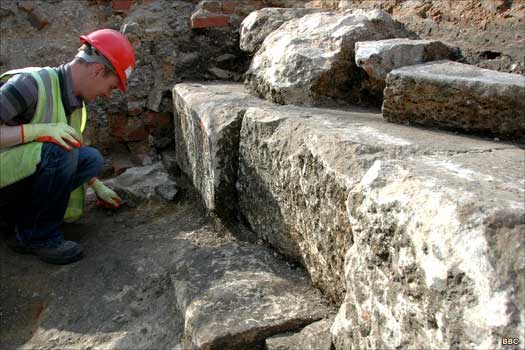 Despite the focus of settlement now being away from the old fort, Glevum's Roman walls were still very much in use in the sixth century, at least until the city's fall to the West Seaxe Despite the focus of settlement now being away from the old fort, Glevum's Roman walls were still very much in use in the sixth century, at least until the city's fall to the West Seaxe |
|
| ? |
Name unknown. |
|
| c.540 |
 The three cities, Caer Gloui, Caer Baddan, and Caer Ceri, still apparently form a single kingdom (called Guenet by Nennius). This seems to be partially borne out when Gildas infers that Aurelius Caninus is ruling his kingdom as a single political entity instead of one of three minor states (see feature link). The three cities, Caer Gloui, Caer Baddan, and Caer Ceri, still apparently form a single kingdom (called Guenet by Nennius). This seems to be partially borne out when Gildas infers that Aurelius Caninus is ruling his kingdom as a single political entity instead of one of three minor states (see feature link). |
|
| fl 540 |
Aurelius Caninus |
High King. Named by Gildas. Still ruled the united three cities? |
| c.550 |
 Around this time, either upon the death of Aurelius or his successor, the unnamed fifth king of Glevum, the single kingdom based at Caer Gloui divides into Caer Baddan, Caer Ceri, and Caer Gloui. This is probably a result of the kingdom being divided between sons, an act which is based on traditional Celtic practise. The act suggests that a true kingship is being practised by this time, rather than the previous Romanised role of magistrate. Around this time, either upon the death of Aurelius or his successor, the unnamed fifth king of Glevum, the single kingdom based at Caer Gloui divides into Caer Baddan, Caer Ceri, and Caer Gloui. This is probably a result of the kingdom being divided between sons, an act which is based on traditional Celtic practise. The act suggests that a true kingship is being practised by this time, rather than the previous Romanised role of magistrate. |
|
| ? |
Name unknown. |
|
| c.570s |
The name of the last king - Conmail, below - is rather remarkable in that it breaks down as 'Con' meaning 'dog' and 'mail/fael' meaning 'servant'. Speculatively speaking, this 'dog servant' may have links to the kings of Glastenning to the south. The king there, Cyndrwyn Glas, is also king of Dogfeilion, which name means 'servant of [the god] Dagda'. 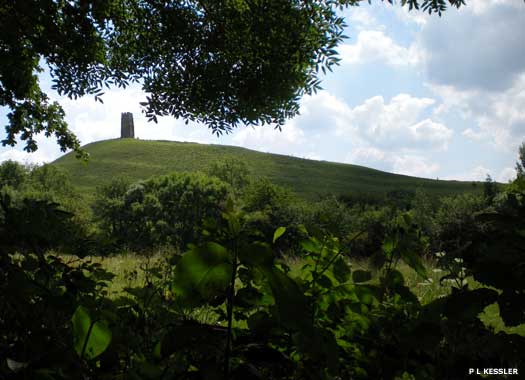 The Glastonbury region, nominally part of Dumnonia, seems to have experienced a power vacuum in the mid-fifth century which allowed the Dogfeilion kings to walk in and take over The Glastonbury region, nominally part of Dumnonia, seems to have experienced a power vacuum in the mid-fifth century which allowed the Dogfeilion kings to walk in and take over |
|
| However, a much more likely reason is the sense of humour sometimes exhibited by the Welsh (even today) in naming their offspring. Conmail's grandfather, Aurelius Caninus, may well have been alive at the time of his birth. What better jest than to poke gentle fun at the mostly pagan naming convention of 'Cuno-' ('cyn') added to this or that god than by naming someone just plain 'dog' (the second name in 'Aurelius Caninus' is the Latin for 'dog'), and then in his grandson combining it with the mostly Christian convention of mal/mail/mael? |
|
|
| ? - 577 |
Conmail / Cynfael |
Last British king. Killed fighting the West Seaxe. |
| 577 |
Caer Gloui, together with Caer Baddan and Caer Ceri, falls to the West Seaxe following the Battle of Deorham or Dyrham (an event which is rather obtusely doubted by some but which would be entirely in keeping with the pattern of Saxon advance to the west). With this collapse, the territory of Caer Celemion to the east is now totally isolated, and Dumnonia is cut off from any overland contact with other surviving British territories. Gwent and Pengwern now form the western frontier against further Saxon advances. 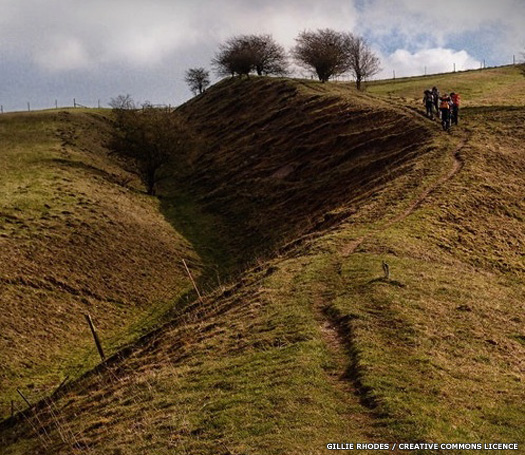 The fifth or perhaps sixth century construction of the Wansdyke was a massive undertaking which reached from west of Caer Baddan's capital (Roman Aquae Sulis, modern Bath) to the proposed north-western corner of Caer Celemion's border (External Link: Creative Commons Licence) The fifth or perhaps sixth century construction of the Wansdyke was a massive undertaking which reached from west of Caer Baddan's capital (Roman Aquae Sulis, modern Bath) to the proposed north-western corner of Caer Celemion's border (External Link: Creative Commons Licence) |
|
| The Hwicce take over the territory and eventually push its borders north into Worcestershire, at the expense of Pengwern. However, rather than simply sweep away all that is British, they appear to form a new top layer of aristocracy over a largely British population which retains much of what it had before, possibly even down to its church organisation, even while early [England](EnglandWessex.htm#Kingdom United) is forming around it. |
|
|
 |
|
|
 With the expulsion of Roman officials in AD 409 (see feature link), Britain again became independent of Rome and was not re-occupied. The fragmentation which had begun to emerge towards the end of the fourth century now appears to have accelerated, with minor princes, newly declared kings, and Roman-style magistrates all vying for power and influence while also facing the threat of extinction at the hands of the various barbarian tribes which were encroaching from all sides. [
With the expulsion of Roman officials in AD 409 (see feature link), Britain again became independent of Rome and was not re-occupied. The fragmentation which had begun to emerge towards the end of the fourth century now appears to have accelerated, with minor princes, newly declared kings, and Roman-style magistrates all vying for power and influence while also facing the threat of extinction at the hands of the various barbarian tribes which were encroaching from all sides. [  ](../FeaturesBritain/BritishSouthernBritain02.htm#Caer Baddan)The Romano-British city of Caer Gloui had been founded by the Romans as Glevum (modern Gloucester - see feature link). It was first settled around AD 49 as a legionary fort, and a city grew up around this. During the fourth century AD it probably served as the capital of the province of Britannia Prima within the Diocese of the Britains, and it seems to have retained its importance into the fifth century. While the later name of Caer Gloui is used here, the name of the territory it commanded has not survived, and in the fifth century the city may instead have been known as Glouvia. Central administration of Britain appears to have broken down in the early fifth century, to the extent that the regions began to establish partially or wholly independent districts or kingdoms. The administration at Caer Gloui would have found itself in command of much of the land around the mouth of the Severn, which also appears from the scant evidence available (plus a fair amount of tradition and later writing) to have encompassed the cities of Caer Baddan and Caer Ceri to the south, essentially making it a successor to the former Dobunni tribal territory. In the sixth century, this Romanised district seems to have evolved into a kingdom, and its eventual fall is noted in the Anglo-Saxon Chronicle. After that, the incoming Hwicce who took control of the area maintained the city's name, albeit mispronouncing it in their very individual Teutonic language, so that it survives today. Romano-British 'glou' of Glouvia or Glevum became the Saxon 'gloe', with '-cester' being added from the Latin 'castrum', meaning 'fort', to emerge as Gleawanceaster (Gloucester). That early form, 'Gleawan-ceaster' does suggest that 'Glevum' was in use in later days prior to conquest. It should be noted that the Brythonic language has gone through five stages to reach modern Welsh: 'Primitive' (in the 500s-700s), Old Welsh (in the 800s-1000s), Middle Welsh (in the 1100s-1400s), 'Early Modern' (in the 1400s-1700s), and 'Late Modern' thereafter. Until the 'Middle', the word 'caer' was actually 'cair', from the Brythonic 'cajr', meaning 'fort, fortified place'.
](../FeaturesBritain/BritishSouthernBritain02.htm#Caer Baddan)The Romano-British city of Caer Gloui had been founded by the Romans as Glevum (modern Gloucester - see feature link). It was first settled around AD 49 as a legionary fort, and a city grew up around this. During the fourth century AD it probably served as the capital of the province of Britannia Prima within the Diocese of the Britains, and it seems to have retained its importance into the fifth century. While the later name of Caer Gloui is used here, the name of the territory it commanded has not survived, and in the fifth century the city may instead have been known as Glouvia. Central administration of Britain appears to have broken down in the early fifth century, to the extent that the regions began to establish partially or wholly independent districts or kingdoms. The administration at Caer Gloui would have found itself in command of much of the land around the mouth of the Severn, which also appears from the scant evidence available (plus a fair amount of tradition and later writing) to have encompassed the cities of Caer Baddan and Caer Ceri to the south, essentially making it a successor to the former Dobunni tribal territory. In the sixth century, this Romanised district seems to have evolved into a kingdom, and its eventual fall is noted in the Anglo-Saxon Chronicle. After that, the incoming Hwicce who took control of the area maintained the city's name, albeit mispronouncing it in their very individual Teutonic language, so that it survives today. Romano-British 'glou' of Glouvia or Glevum became the Saxon 'gloe', with '-cester' being added from the Latin 'castrum', meaning 'fort', to emerge as Gleawanceaster (Gloucester). That early form, 'Gleawan-ceaster' does suggest that 'Glevum' was in use in later days prior to conquest. It should be noted that the Brythonic language has gone through five stages to reach modern Welsh: 'Primitive' (in the 500s-700s), Old Welsh (in the 800s-1000s), Middle Welsh (in the 1100s-1400s), 'Early Modern' (in the 1400s-1700s), and 'Late Modern' thereafter. Until the 'Middle', the word 'caer' was actually 'cair', from the Brythonic 'cajr', meaning 'fort, fortified place'.  Just about all the (extremely scanty) information available about the post-Roman city and the events of the sixth century comes from the Welsh Triads, or from Gildas' De Excidio Britannia, Nennius' Historia Brittonum (see feature link), and Geoffrey of Monmouth's Historia Regum Britanniae, plus a little from Bede. While Gildas and Bede can be said to be reliable, Nennius seems to be less so, and Geoffrey is prone to wild flights of fancy while still retaining a distinct foothold in events which must have been recorded by sources earlier than him. The powerful figure of Vortigern of the Paganes has a claim on the region as a power base until his fall in the mid-fifth century. After that, it seems highly likely that Caer Gloui was one of the centres of operations for Ambrosius Aurelianus during his battles against the Saxons in the south. It is possible that his father also called this territory home. Descendants of the two men seem to have used this connection as a basis for their own claims on the later kingdom. So little is known about Ambrosius other than through the writers mentioned above that it cannot be certain that he specified their continued rule in the city. However, the trend in the south does appear to have been one of magistrates controlling their cities and districts on an increasingly isolated basis, one which would quite naturally slip into kinghood across successive generations. Ambrosius is also a likely reason for the naming of nearby Amesbury. That name is a Saxon version of what must originally have been a Brythonic name. It can be broken down into 'Ambrose byrig', meaning 'the fort of Ambrosius'. The location makes it an ideal forward observation point on the River Avon, a short way to the south of the Vale of Pewsey.
Just about all the (extremely scanty) information available about the post-Roman city and the events of the sixth century comes from the Welsh Triads, or from Gildas' De Excidio Britannia, Nennius' Historia Brittonum (see feature link), and Geoffrey of Monmouth's Historia Regum Britanniae, plus a little from Bede. While Gildas and Bede can be said to be reliable, Nennius seems to be less so, and Geoffrey is prone to wild flights of fancy while still retaining a distinct foothold in events which must have been recorded by sources earlier than him. The powerful figure of Vortigern of the Paganes has a claim on the region as a power base until his fall in the mid-fifth century. After that, it seems highly likely that Caer Gloui was one of the centres of operations for Ambrosius Aurelianus during his battles against the Saxons in the south. It is possible that his father also called this territory home. Descendants of the two men seem to have used this connection as a basis for their own claims on the later kingdom. So little is known about Ambrosius other than through the writers mentioned above that it cannot be certain that he specified their continued rule in the city. However, the trend in the south does appear to have been one of magistrates controlling their cities and districts on an increasingly isolated basis, one which would quite naturally slip into kinghood across successive generations. Ambrosius is also a likely reason for the naming of nearby Amesbury. That name is a Saxon version of what must originally have been a Brythonic name. It can be broken down into 'Ambrose byrig', meaning 'the fort of Ambrosius'. The location makes it an ideal forward observation point on the River Avon, a short way to the south of the Vale of Pewsey.
 Aurelius Ambrosius is the official representative of Roman Emperor Honorius to the British provincial council and is claimed as a prince, marking him out as a member of the Romano-British nobility. The country is reorganising at this time, following the expulsion of Roman administration (see feature link), but links with Rome are clearly being maintained.
Aurelius Ambrosius is the official representative of Roman Emperor Honorius to the British provincial council and is claimed as a prince, marking him out as a member of the Romano-British nobility. The country is reorganising at this time, following the expulsion of Roman administration (see feature link), but links with Rome are clearly being maintained.  Ravenna became an imperial city in 402, and remained Italy's capital under succeeding Gothic, Ostrogothic, and Eastern Roman administrations, but without Britain or even much of Gaul
Ravenna became an imperial city in 402, and remained Italy's capital under succeeding Gothic, Ostrogothic, and Eastern Roman administrations, but without Britain or even much of Gaul With discord building in the country between about 420-450, many Romano-Britons left in a hurry, burying their wealth in the hope that they could return in better times to collect it
With discord building in the country between about 420-450, many Romano-Britons left in a hurry, burying their wealth in the hope that they could return in better times to collect it Ambrosius (the Elder) has long been Vortigern's main rival (see feature link), with it seeming likely that they not only head two opposing factions in the country, but also opposing ideologies, with Ambrosius retaining his Romanised, Roman Church background while Vortigern is leader of the Pelasgian pro-Celtic party which seems to proliferate within the British Church. Around this year, 437 or 438, internecine warfare breaks out between the two rival factions, resulting in the Battle of Guolloppum (Cat Guolph, today's Wallop in Hampshire - the name is the same, but has been filtered through fifteen hundred years of language evolution). The result is uncertain, but it is probably followed by a period of civil strife in eastern and southern Britain.
Ambrosius (the Elder) has long been Vortigern's main rival (see feature link), with it seeming likely that they not only head two opposing factions in the country, but also opposing ideologies, with Ambrosius retaining his Romanised, Roman Church background while Vortigern is leader of the Pelasgian pro-Celtic party which seems to proliferate within the British Church. Around this year, 437 or 438, internecine warfare breaks out between the two rival factions, resulting in the Battle of Guolloppum (Cat Guolph, today's Wallop in Hampshire - the name is the same, but has been filtered through fifteen hundred years of language evolution). The result is uncertain, but it is probably followed by a period of civil strife in eastern and southern Britain.  Following the break with Rome in AD 409 there came a period in which central administration apparently began to break down, with no single individual with enough power to hold the Romanised administrative structure together (click or tap on map to view full sized)
Following the break with Rome in AD 409 there came a period in which central administration apparently began to break down, with no single individual with enough power to hold the Romanised administrative structure together (click or tap on map to view full sized) Times were tough in the mid-fifth century, and Britain's resources were not what they had once been, what with barbarians at the door and withdrawal from the fading Roman empire, so Caer Gloui's amphitheatre had to be made defendable (Nemausus (Nimes) amphitheatre is shown here as an example)
Times were tough in the mid-fifth century, and Britain's resources were not what they had once been, what with barbarians at the door and withdrawal from the fading Roman empire, so Caer Gloui's amphitheatre had to be made defendable (Nemausus (Nimes) amphitheatre is shown here as an example) He probably governs the territory as a Roman magistrate rather than as a princeps or king (although he is claimed as the first king by later chroniclers, and see feature link). It seems likely that the Wansdyke is constructed around this time, possibly in response to further Saxon incursions to the east.
He probably governs the territory as a Roman magistrate rather than as a princeps or king (although he is claimed as the first king by later chroniclers, and see feature link). It seems likely that the Wansdyke is constructed around this time, possibly in response to further Saxon incursions to the east.  The Thames Valley forms an east-west passage through the hills between London and Surrey and also through the hills of Wiltshire, providing easy access for river users to the River Avon around Bath
The Thames Valley forms an east-west passage through the hills between London and Surrey and also through the hills of Wiltshire, providing easy access for river users to the River Avon around Bath All building and repair work on major new defensive works probably comes to an end with the British victory of Mons Badonicus around 496, with the siege possibly being fought outside Caer Baddan (see feature link).
All building and repair work on major new defensive works probably comes to an end with the British victory of Mons Badonicus around 496, with the siege possibly being fought outside Caer Baddan (see feature link). Despite the focus of settlement now being away from the old fort, Glevum's Roman walls were still very much in use in the sixth century, at least until the city's fall to the West Seaxe
Despite the focus of settlement now being away from the old fort, Glevum's Roman walls were still very much in use in the sixth century, at least until the city's fall to the West Seaxe The three cities, Caer Gloui, Caer Baddan, and Caer Ceri, still apparently form a single kingdom (called Guenet by Nennius). This seems to be partially borne out when Gildas infers that Aurelius Caninus is ruling his kingdom as a single political entity instead of one of three minor states (see feature link).
The three cities, Caer Gloui, Caer Baddan, and Caer Ceri, still apparently form a single kingdom (called Guenet by Nennius). This seems to be partially borne out when Gildas infers that Aurelius Caninus is ruling his kingdom as a single political entity instead of one of three minor states (see feature link). Around this time, either upon the death of Aurelius or his successor, the unnamed fifth king of Glevum, the single kingdom based at Caer Gloui divides into Caer Baddan, Caer Ceri, and Caer Gloui. This is probably a result of the kingdom being divided between sons, an act which is based on traditional Celtic practise. The act suggests that a true kingship is being practised by this time, rather than the previous Romanised role of magistrate.
Around this time, either upon the death of Aurelius or his successor, the unnamed fifth king of Glevum, the single kingdom based at Caer Gloui divides into Caer Baddan, Caer Ceri, and Caer Gloui. This is probably a result of the kingdom being divided between sons, an act which is based on traditional Celtic practise. The act suggests that a true kingship is being practised by this time, rather than the previous Romanised role of magistrate. The Glastonbury region, nominally part of Dumnonia, seems to have experienced a power vacuum in the mid-fifth century which allowed the Dogfeilion kings to walk in and take over
The Glastonbury region, nominally part of Dumnonia, seems to have experienced a power vacuum in the mid-fifth century which allowed the Dogfeilion kings to walk in and take over The fifth or perhaps sixth century construction of the Wansdyke was a massive undertaking which reached from west of Caer Baddan's capital (Roman Aquae Sulis, modern Bath) to the proposed north-western corner of Caer Celemion's border (External Link: Creative Commons Licence)
The fifth or perhaps sixth century construction of the Wansdyke was a massive undertaking which reached from west of Caer Baddan's capital (Roman Aquae Sulis, modern Bath) to the proposed north-western corner of Caer Celemion's border (External Link: Creative Commons Licence)